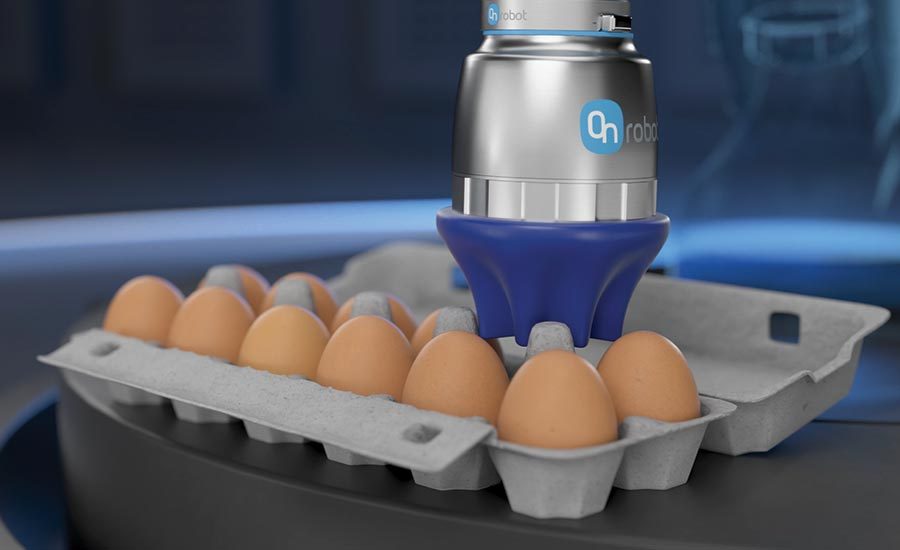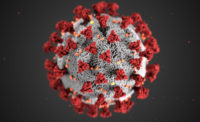If there were ever a time you could use some help from robotics, it would probably be now. Whether you just need some extra “hands” due to team members out sick at home or want to implement social distancing, robots in the right places could help you out of a bind.
Robots are getting better and better at food and beverage applications—for several reasons:
- Improved vision capabilities
- New abilities to withstand harsh cleaning chemicals and temperatures
- Hygienic designs
- Flexibility to adapt to changing applications, recipes and throughput
- Ability to work safely among people
- Sensitive grippers like human hands
- Artificial intelligence, fostering machine learning
- Specialized robotics to handle difficult, repetitive tasks
While there are some robotics applications still waiting to be perfected, especially in the protein handling area, you can find robots for every job; for example in the ABB Robotics lineup, 4- and 6-axis articulated arm robots, delta robots, SCARA (selective compliance assembly robot arm), and collaborative robots, aka cobots.
More specialized robots can take the form of dedicated cell functions, such as pork carcass cutting/trimming or APRIL Robotics’ cooking cell (“Robot Chef”) or Cartesian systems, which typically work in an X-Y plane (sometimes 2.5 dimensions) and are often used in gantry systems or pallet stacking. In this article, we’ll look at some practical robotic solutions that can help you get through the COVID-19 crisis and describe some tools to help you be more competitive both now and in the future.
How COVID-19 has reshaped thinking on robotics
(Editorial note: Just as COVID-19 has affected the way you do business, it has also affected the way robotics suppliers handle service and maintenance. Be sure to read “How robotics suppliers handle service and maintenance in a COVID-19 environment.”)
“While COVID is the greatest single catalyst for change in industry in a generation, the global lockdown hasn’t started any new trends on its own,” says ABB’s Joe Chudy, vice president and general manager. “It has accelerated existing trends, such as reshoring/near-shoring to improve supply chain resilience, having production lines that are more flexible and better able to cope with significant changes in demand, or processing without human contact.”
Since the onset of the COVID-19 pandemic, there has been increasing interest by food and beverage processors to look at how robotics can help address their need to social distance humans in their facilities, says James Cooper, FANUC America executive director global accounts. These applications are wide ranging and really open for consideration, as is any application being conducted by humans.
ABB customers are seeing the need to accelerate the adoption of robotics and automation to protect employees’ health and enhance business continuity, with businesses increasingly focused on flexibility and simplicity (of installation and use), says Chudy. Where robots had been used traditionally for simpler processes like pallet loading, processors are looking at higher value tasks upstream, for example preparing the food—with a focus on traceability, food safety and hygiene.
Prior to COVID-19, the thinking was that to increase process output, a manufacturer just added more people to a line.
“In the COVID-19 world, this just isn’t possible so food manufacturers must seek out alternative solutions to ensure they can keep running, and in some cases, robotics can help them boost productivity while keeping people safe,” says Jake Norman, head of sales and innovation at OAL’s APRIL Robotics.
“OAL (Olympus Automation Ltd.) has successfully automated the manufacture of complex soups and sauce products with our APRIL Robotics food manufacturing system,” adds Norman. Using only a single operator, different soups and sauces can be made at rates of up to 13,000 lbs/hr. That single person is now responsible for loading the system with raw ingredients and the rest of the process is fully automatic, ensuring that social distancing is in place and reducing manufacturers’ reliance on labor. This incorporates automating complex tasks including weighing, liquid dosing, mixing, heating, pasteurizing and cleaning.
Social distancing requirements are disrupting the layout of processing and packaging lines, says Kristian Hulgard, general manager, OnRobot, Americas.
“In these cases, we’re seeing interest in using small and/or collaborative robot arms in place of human workers to help maintain distancing requirements. Food and beverage processors are most interested in our Soft Gripper and in our vacuum grippers, which find many uses in packaging and palletizing operations.”
Couple these needs with, perhaps, the most important requirement: Robots should be intuitive and simple to use, set up and program, as robotics experts aren’t often available on-site.
Sick people can’t work
Besides the social distancing that robotics provides in the above application, the push for automation is greater with different justifications and ROIs, says Sam Collup, Cantrell-Gainco Group director of sales. But a primary reason to employ robotics is to reduce the dependence on skilled, manual labor, which has been an issue with people getting sick.
“We have noticed the effects that COVID-19 is having on the way food and beverage processors look at manufacturing,” says Cory Knight, automation engineer for Festo’s food and beverage segment. “We’ve seen increased attention in several applications where manual labor is prevalent.”
Some of those areas include case packing and inspection for products such as raw and cooked meats, dairy and confectionery. Sometimes the solution is as simple as automating a manual task, such as rotating the product or case 90 degrees or verifying that the packaging equipment is operating properly with the use of machine vision. Other times, solutions are more complex such as automating the loading of raw goods and unloading of finished goods.
Many food and beverage processors are alternating crews to reduce exposure in an attempt to mitigate disruption to production due to worker illness, says Laura Studwell, Omron Automation Americas industry marketing manager, packaging.
“We have seen a substantial increase in robotic interest—from processing to packaging and even in warehousing.”
Upstream, in the primary handling stage, many food and beverage companies are looking for parallel, or pick-and-place robots. Omron’s IP69K stainless steel parallel robot is suited to environments with strict washdown regimes. In the meat, poultry and agricultural segments, there’s an increased interest in Omron’s USDA-approved parallel robot, which helps meet USDA equipment regulations.
But worker illness doesn’t just affect processing, says Studwell. It also affects workers handling warehousing applications, such as bin picking and delivery to workstations. “We are also seeing interest in integrated robotics such as our mobile manipulator (MOMA), which is a combination of collaborative and mobile technologies.”
“We have seen a steady increase in the need for robotics to replace manual handling,” says Naomi Holdvogt, director, marketing, ProMach robotics and end of line, Quest Industrial. The filling of single/multicompartment trays, bowls or clamshell containers are highly manual processes. Food-safe robotics can provide an automated solution for each of these applications, says Holdvogt. When automated with robotics, such as filling and pick-and-place, those touches disappear, and any issues with viral contamination are negated.
Replacing human repetitive tasks by automation, whether robotics or traditional, has been a trend for a long time, and the pandemic is only accelerating these ongoing trends, says Didier Saussereau, packing product manager at Sidel. While palletizing applications have been handled by traditional robotics, cobotic palletizing solutions are finding their way in many packaging lines for their affordability, safety and compactness advantages.
But when it comes to other applications, the need of robotics is increasing due to the higher level of complexity that manufacturing sites are facing, adds Saussereau. Increasing numbers of products/references/SKUs or distribution channels are forcing brand owners to deliver production in shorter runs with more frequent changeovers. Robotics is helping in not only simplifying the equipment itself (removing lots of mechanical replacement parts used in traditional solutions), but also consequently simplifying the changeover operations, making them fully automatic or very easy to perform by a single operator—most of the time without any tool required.
Employee absences and social distancing due to COVID-19 have piqued interest in deploying collaborative robots to fill in the gaps, literally speaking, according to Joe Campbell, senior manager of applications development for Universal Robots, USA.
“Our cobots and supporting products are designed to enable easy deployment of cobots in all sorts of applications from packaging and palletizing through pick and place, and machine tending. Our robots are easy to move around, easy to program and can be used across a wide range of applications. For producers forced to implement social distancing rules on packed lines, cobots offer a way to ensure distancing compliance and a way to maintain production levels regardless of labor shortages.”
Heavy lifting or speed and accuracy describe two types of robots from Kawasaki Robotics. According to Samir Patel, senior director—robotics engineering, both the R series and Y series are suited to food and beverage applications and can handle payloads from 3 to 1500 kg. The R series are articulated robots, i.e., they have mechanical links connected by powered rotary joints, and they operate in a spherical workspace around their base. They handle payloads from 3 to 80 kg and have a reach from 620 to 2100 mm. The Y series (delta or spider) robots are designed for pick and place of food products with vision guidance at speeds of about 100 picks per minute, mount on an overhead structure and use food-grade lubricants.
COVID-19 and hygienic design
To operate in the food industry, equipment has to meet hygienic design requirements plus be able to withstand harsh cleaning chemicals at elevated temperatures. So I asked: Is there anything specific to coronavirus that would have an impact on robot design?
“FANUC has been increasing the number of robots being offered with food safety and hygienic design considerations,” says Cooper. Certainly the COVID-19 pandemic has increased the interest in the implementation of robots with these design considerations.
“Many in the industry rely on the American Meat Institutes’ 10 standards of sanitary design, says Cantrell-Gainco Group’s Collup. “I would expect a further push in this direction for not only ready-to-eat products but ready-to-cook products as well. One of the easiest design changes is to incorporate nontubular frames, supports and rollers to eliminate a harborage of bacterial growth. At Cantrell-Gainco we utilize these standards in our equipment design and modify other OEM equipment we distribute to meet these requirements for certain customers. Some of our OEM partners now offer increased hygienic design as an option. I think this will become the new standard required by North American customers.”
How do you keep robotic equipment germ free? Kosuke Matsumoto, senior engineer with Mayekawa Robot Products, responds: “HAMDAS and WANDAS are already equipped with an alcohol sterilization device for their robot-knife. Periodical sterilization minimizes the contamination. We are planning to add a periodical alcohol spray function to the meat contact surface of the machine as well as a remote maintenance option due to the overseas travel restriction with COVID-19.”
Regardless of the length of time COVID-19 survives on surfaces, many food processors are turning to stricter washdown regimes with higher wash pressures and temperatures, as well as harsher chemicals, says Omron’s Studwell. With many types of pathogens that cause illness beyond the new coronavirus, it’s critical to incorporate equipment and components—stainless steel and IP69K-rated with rounded, sloping surfaces—that can withstand washdown.
Clean design, says Sidel’s Saussereau, means no retention zones or flat surfaces to collect dust or dirt. But hygienic options should fit applications and equipment. “For instance, the cobot that we integrated in our CoboAccess_Pal M version has an IP67 rating with an easy-to-clean surface, enabling its use in sanitary environments. It also includes NSF H1 food-grade grease for use in spaces where there is a possibility of incidental food contact.”
An additional approach that protects a robot and makes it easier to clean is based in coating technology. Quest Industrial’s Holdvogt explains: Qleen Coat Robotic Coating is Quest’s proprietary robotic coating developed while working in the food industry and seeing the effects of cleaning practices on the standard factory finish. Quest applies the coating after the robot is assembled while in its factory. This system uses several different polymers that help resist damage from cleaning processes that use strong acids, bases, etc. This coating, paired with Quest’s suggested cleaning method, not only protects the finish, but also gives the robot a bright, quality sheen. End users gain the comfort of knowing they are running a clean system.
Vision and AI
Machine vision systems offer speed, accuracy and repeatability beyond human ability, making them important tools for inspection, measurement and verification tasks, says Universal Robots’ Campbell. Recent strides in customizable vision include solutions that can easily be swapped out and tailored to individual needs.
Most robotics companies have integrated vision and artificial intelligence into their machines, so users don’t have to mix and match or build from scratch. FANUC offers a wide range of integrated vision technologies, says Cooper, including 2D and 3D for stationary and moving products. Today’s systems allow a robot to grasp an object based on its 3D shape—not its two-dimensional outline. AI can detect products out of norm, for example a missing pepperoni slice on a pizza.
“At the simplest level, food and beverage producers must make certain their process satisfies consumer, regulatory and supplier needs,” says ABB’s Chudy. Machine learning and AI deliver assurances while increasing quality, efficiency, productivity and sustainability. The benefits of AI are not limited to quality control but also include powerful process monitoring and more accountability.
Deep learning tools, such as neural networks, are now coming to the spotlight since they provide a powerful method of detecting variable products once the network has been trained, says Festo’s Knight. Some examples include detection and ripeness grading of pre- and post-harvested fruits and vegetables, food tray quality inspection, lean to fat grading in raw meat processing, and chocolate bar quality inspection.
On Mayekawa pork deboning machines, Matsumoto says an X-ray based vision system acquires the necessary information to make precise cuts as each piece of pork varies. The vision system provides the information for the robotics to adjust torques as necessary in real time.
“We recently launched OnRobot Eyes, a flexible 2.5D vision system that provides depth information for stacked objects and objects of varying heights,” says OnRobot’s Hulgard. Eyes is a flexible, adaptable vision system that allows users to easily sort, pick and place unstructured items with high reliability using any robot arm. One-picture calibration and part recognition takes just minutes, and programming is intuitive and fast.
Further reading: Cobotics and specialized applications
Don’t miss the second part of this article, “A further look at robotic vision systems and roles for cobotics,” where we delve further into vision, then look at cobotics and specialized applications. We’ll also cover robotic cutting and trimming systems and other specialized robotic applications.
Online Resources:
OSHA: “Industrial Robots and Robot System Safety”
National Institutes of Health (Section on cobots): “Working Safely with Robot Workers: Recommendations for the New Workplace”
NSF: “National Robotics Initiative 2.0: Ubiquitous Collaborative Robots (NRI-2.0)”
IEEE/NIST: “Characterizing Task-Based Human-Robot Collaboration Safety in Manufacturing”
For more information:
ABB Robotics, www.abb.com/products/robotics
APRIL Robotics, www.oalgroup.com/april-robotics
Cantrell-Gainco Group Inc., www.cantrellgainco.com
FANUC America, www.fanucamerica.com
Festo, www.festo.com/us
Kawasaki Robotics, https://robotics.kawasaki.com
Mayekawa Robot Products, https://mayekawa.com/americas
Omron Automation Americas, www.automation.omron.com
OnRobot, www.onrobot.com
Quest Industrial/ProMach, www.questindustrial.com
Sidel, www.sidel.com
Universal Robots, www.universal-robots.com










